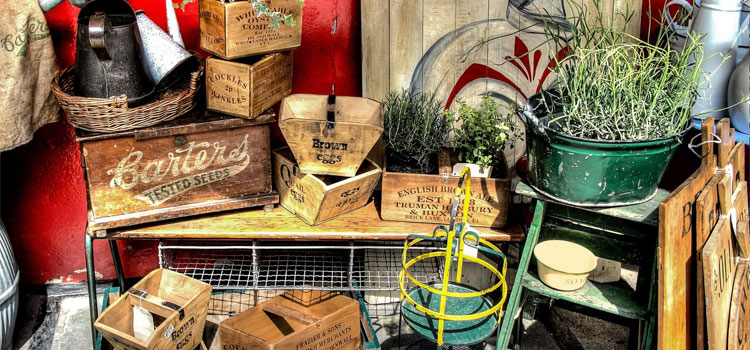If you’re looking for garage sale tips, you’ve come to the right place!
I’m pretty sure I’m not the only one who finds fulfillment in turning unwanted clutter, stored clothes, and old house items into cash.
You can sell items on eBay, Craigslist, and selling apps like Poshmark, but the traditional garage sale is usually enough to do the trick.
The garage sale tips I’m going to share with you are based from personal experience, and have always worked no matter the season.
What Sells Best at a Garage Sale
In the past, I discussed quite a bit about product research and the best things to sell on Amazon, Etsy, eBay, and other online platforms.
Unfortunately, online selling is totally different to traditional yard sales. What sells best at a yard sale may not really sell successfully online…and vice versa. And that’s okay.
Items that sell best at yard sale include:
- Tools – This can be anything from power tools to gardening tools, and everything else in between. These items sell like hotcakes on yard sales because they don’t get broken too easily, so even if the tools are used, they most likely still have half of their lifetime to spare.
- Gently-used clothes and costumes – A yard sale shouldn’t include clothes that are no longer usable. As a general rule: if it won’t be usable for you, no other person will find it usable. Costumes are bestsellers, since most of them are only worn once or twice.
- Shoes and bags – Kids shoes are quick sellers because children grow out of their sizes very quickly. Parents grab second-hand shoes on yard sales since they’re cheaper than new and rarely worn out. When it comes to bags, branded ones can be a hit, especially if you still have the original boxes or paper bags.
- Jewelry – Selling real jewelry in a garage sale doesn’t really happen, but if you’re game for it, then do so. Many yard sale junkies, however, flock toward costume jewelry or other fashionable statement pieces, so price them appropriately.
- Antiques and Artwork – Since many homeowners who have kept heirloom pieces may never know the real value of what they have, antique hunters and art collectors check out garage sales regularly in hopes of finding hidden gems. When selling art and antiques, try to find everything you can about the pieces before “laying them on a table.”
- Books – If you have experience selling books on Amazon or any online platform, you know that there will always have a demand for books. Pile your books altogether in one spot and price them somewhere between $1 to $5.
- Camping gear – Tents and other camping gear can be expensive. But since most people who have camping gear rarely use them, they’re sure-buys on garage sales.
- Furniture and appliances – For many families that are just starting out, second-hand furniture and appliance are the only way to go, so if you have an old sofa you’re not using or a study table outgrown by your kids, not only are these a sure sell, but you’re also helping people out.
- Sports and exercise equipment – Got some exercise equipment collecting dust? This can be anything as small as dumbbells or exercise balls, to something as big as a stationary bike. How about some sports equipment like golf clubs, basketballs, rackets, and so on? Know that they’re always in-demand.
- Anything in bulk – Put stuff in a box (makeup, comics, toys, etc.) and sell them as a bundle. People love discounted items grouped together like a gift box.
Negotiations and Garage Sale Pricing
Garage sale pricing can be tricky, especially if you only do yard sales every couple of years. Buyers would likely negotiate – it’s the norm in yard sales, so you better be prepared and set your limits before opening your doors to the world.
Here are several things to remember when it comes to pricing:
1. Visit other yard sales in your area
Take note of the prices of items, so you’d have a feel for what people locally are buying and for how much they’re willing to spend for them.
2. Price everything before the garage sale starts
Get stickers and write down prices using a permanent marker.
Keep the price of big-ticket items like sofa or heirloom cabinets private (list them down in a notebook or on your phone’s notepad), so you have a starting amount when would-be buyers decide to negotiate price.
Place same-priced items in one spot.
Books priced at $1 each can go in a box.
3. Choose your stickers properly
Neon-colored stickers let buyers see price quickly.
Go with low-tack stickers, which area easier to remove from glass, paper, wood or porcelain.
If the garage sale includes items of your friends and family, various-colored stickers will make your job easier.
Double the sticker to every item, then whenever an item is sold, get the second sticker and put it in a column under your friend or family member’s name.
It’s a quick and easy way to keep everything accounted for.
Be considerate about collector’s items.
Don’t place hard-to-remove stickers on old album covers, windows of collectable toy boxes, and other areas that would de-value the price of the actual item.
4. Never shut down buyers who haggle
It’s part of the garage sale experience.
Add the word “firm” to price stickers for items that have non-negotiable pricing
Generally, clothes range from $1 to $5, while coats and formal wear go a bit higher (around $5 to $15). Shoes can be as low as $2 to up to $10, depending on the amount of wear. Jewelry can be sold as little as 25cents for costume jewelry and up to $20 for antiques.
Books, DVDs or VHS tapes of movies and music, toys, and vinyl records are usually $2 or less.
Kitchen items like knives, silverware, dishware, glassware, and other similar items are priced from $1 to $5.
Of course, those that come in sets (set of knives, 6-pc plate set, etc.) can get over $15 or more.
5 Awesome Garage Sale Tips for a Successful Yard Sale
To ensure your yard sale comes out successful, here are tried-and-tested garage sale tips you can follow:
1. Plan
Be smart about your garage sale.
Plan the date, season, day and time. People prefer to visit yard sales at the end of the week, so choose 2-3 days from Thursday to Sunday.
Go for the nearest weekend after the 15th and 30th (or the nearest payroll date in your state).
If you can start your sale early in the morning, it will attract more buyers with school kids going to school or adults off to work.
If they couldn’t stop by that morning, there’s a good chance they’d be intrigued and stop over on the way back.
And while you’re at it, check weather forecast as well.
Not only will rain cause a lot of hassle with things getting wet, the chances of people stopping over reduces significantly with bad weather.
2. Organize
Planning and organizing may not be the newest or coolest garage sale tips ever, but doing them will definitely make a difference in the outcome of your yard sale.
Doing so allows you to see all items for sale, make an inventory, and group them according to the categories you prefer, such as entertainment, furniture, kids section, sports, and so on.
Organizing items also make the yard sale look more appealing to the buyers.
You don’t want your second-hand items looking like they’re ready to be disposed, right?
3. Encourage your friends, family or neighbors to join
Ask your friends, family or neighbors join your garage sale. Don’t consider them as competition.
People are often drawn to a yard full of stuff, so the more items you include in your garage sale, the better turnout you’ll have.
4. Spread the Word
Traditional ways of marketing still work.
Aside from word-of-mouth, you can also send flyers around your city and put posters up at the community center (and in front of your house).
Of course, online promotions can help too! Make a listing on Craigslist, find your town’s FB page and post there, post on your Facebook (and buy credits to spread it to people who live near you) and so on.
Buyers won’t just visit your garage sale. You have to do a big of legwork to increase your chances of a successful yard sale.
5. Include other Fund-Raising Opportunities During a Garage Sale
If you’re planning a big garage sale, or a neighborhood-wide yard sale, you can make extra money by offering people with drinks, baked goods, snack, CR use, phone charging, and so on.
It’s a smart way to keep kids busy while their parents shop. Having a lemonade table, or a hotdog stand during the garage sale also encourages socialization, so if you’re looking for new friends, the yard sale will be an awesome experience.
The Future of Garage Sales
It’s always nice to know that we could sell things to make money the old-fashioned way, right?
As long as there’s no zombie apocalypse keeping people from going outdoors and socializing within the local neighborhood, garage sales will always be in fashion.

